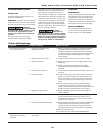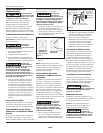
2
Operating Instructions
www.chpower.com
Operation (Continued)
2. Place the resin disc in front of the
appropriate size pad and push the
adapter lock down through the center of
the pad and discs.
3. Hand tighten the adapter lockdown,
then insert the holding tool into the
hole shown in Figure 2. Insert a large
screwdriver into the slotted hole on the
adapter lock down and securely tighten.
DUAL ACTION SANDERS
Begin sanding with an abrasive grit coarse
enough to remove the high spots and any
excessive roughness. Follow with a second
sandpaper using a grit one to two ranges
finer. Continue with successively finer grits
until the desired finish is obtained. Do not
change from a coarse grit to a very fine
grit in one step. In doing so, it is difficult to
remove swirl marks that might have been
made by the coarse grit abrasive. Always
use the finest grit practical for the sanding
operation.
HIGH SPEED SANDERS
The coarse resin disc is used for removing or
smoothing over welds or blending uneven
metal surfaces. The most common grit is 36
(Campbell Hausfeld MP3264 discs).
Worn or damaged
sanding discs may
break apart causing serious injury.
Always replace discs as needed.
AIR HOSE
Refer to IN170102AV Air Hose Hookup
Installation sheet for hookup specifications.
NOTE: It is not recommended to install a
quick coupler between the sander and the
leader (whip) hose.
Use of a whip hose
prevents accidental
triggering of the tool when pressurized
air is connected to the system.
In addition, the tool’s vibration wears out
quick couplers prematurely.
This air tool
requires lubrication
before the initial use and before and
after each additional use.
Air tools require lubrication throughout
the life of the tool. Follow the outlined
procedures carefully. Campbell Hausfeld air
tool oil (ST1270) is recommended because
this oil cleans, lubricates and inhibits rust all
in one step.
AIR MOTOR LUBRICATION
The air motor must be lubricated daily. An
air motor cannot be oiled too often.
Disconnect the
air tool from the air
supply before lubricating.
1. Disconnect the tool from the air supply.
2. Turn the air tool upside down.
3. Simultaneously (at the same time), pull
the trigger and pour a teaspoon of
Campbell Hausfeld oil in the air inlet.
After an air tool
has been lubri-
cated, oil will discharge through the
exhaust port during the first few
seconds of operation. Thus, the ex-haust
port must be covered with a towel
before applying air pressure. Failure
to cover the exhaust port can result in
serious injury.
4. Release the trigger and connect the air
tool to the air supply. Cover the exhaust
port with a towel then run the air tool
for 7 to 10 seconds. Oil will discharge
from the exhaust port when air pressure
is applied. Continue to run the sander
until no oil is discharged. Wipe all
residual oil from the tool before use.
SPEED ADJUSTMENT
This sander is equipped with a regulator for
speed adjustment (See Replacement Parts List
for Specifications).
ATTACHING SANDING PAD/DUAL
ACTION SANDERS
Adhesive backed discs are recommended.
To apply the sandpaper, align outside edge
and press self adhesive paper onto the pad.
Change sandpaper as needed.
Disconnect the
air tool from the
air supply before attaching the sanding
pad. Do not operate the sander if
sanding pad is not securely tightened.
Always replace a worn or damaged pad.
Serious injury could occur.
1. Lock the drive spindle in place before
attaching the sanding pad. Rotate
the spindle lock until the spindle lock
engages with the drive spindle and hand-
tighten the sanding pad in a clockwise
direction (See Figure 1).
2. Unlock the spindle before applying air
pressure.
NOTE: The spindle lock is for attaching and
removing the sanding pad only! Do not
operate the tool with the spindle locked or
the sander will stall when pressure is applied
to the pad.
ATTACHING SANDING DISCS/HIGH
SPEED SANDERS
3” or 6” resin discs with non-adhesive backs
are recommended. The discs should have
7/8” diameter cutout centers for proper
attachment. For best support when using
discs larger than 3", use all the backup pads
of equal size or smaller than the resin disc
itself (See Fig. 2). To install the resin disc,
follow the outlined procedures.
Disconnect the
air tool from the
air supply before attaching the sanding
disc. Do not operate the sander if
sanding disc is not securely tightened
or serious injury could occur.
1. Assemble the backup pads as shown in
Figure 2. Make sure the recessed center
of the pads face the sander.
Figure 2
4-1/2” Backup
Pad
3” Backup Pad
5-1/2”
Backup Pad
Adapter
Lock
Down
Insert Holding
Tool Here
Figure 1
Drive
Spindle
Spindle
Lock
Operating
Postion
Pad
Assembly
Postion














